PUBLISHER: Estes & Lauriat, Boston, 1872-1898
ABOUT: 143 Washington Street in August 1872; 301 Washington Street 1880; editorial offices to 202 Summer St. in 1899; partnership dissolved in 1889. Numerous subsidiaries including Cassino Art Company. Dana Estes was champion of international copyright (resulting from continued piracy of Chatterbox, a serial for children); formed Aldine Publishing Co. to publish inexpensive royalty editions of works by standard authors. (DLB 49). Succeeded by Dana Estes & Company (1898-1914). ... were not known mainly for their cheap books, but they did do some publishing of cheap twelvemos. They seem to have been the real publishers of the Aldine series, although the books were issued under the imprint of the Aldine Publishing Company [Publishers' Weekly 33:396 (1888)]. Estes & Lauriat were one the many firms which practiced price-cutting during the 1880s. A bookseller, bewailing the poor conditions in the book trade, wrote to the Publishers' Weekly in 1886 that these conditions were partly due to "Estes & Lauriat's regular special sales, and their widely circulated catalogues, reducing the retail to wholesale prices." [Publishers' Weekly 29:278 (1886)]. (Shove).
This publishing firm had its origins when Dana Estes joined Henry Degen. The Degen, Estes and Company publishing firm was the immediate predecessor to Estes and Lauriat which was founded in 1872. Because of financial difficulties Charles Lauriat left the publishing firm in 1898 and Dana Estes carried on with Dana Estes and Company. This publisher was well known for deluxe bindings. Among its most well known publications were the Zigzag books by Hezekiah Butterworth.--(Sternick's Tom Brown bibliography).
Dana Estes (1840-1909) and Charles Emelius Lauriat (1842-1920) established Estes & Lauriat in August 1872 and continued the firm under this name, with a number of changes in personnel over the years, until 1898. At that time, Lauriat bought out the published stock of Estes and opened a retail book store on Washington Street, Boston. Estes continued the publishing business under the name Dana Estes & Co. until, by 1915, it was fully absorbed by L. C. Page & Co. (Page being the son of Estes second wife, adopted by Estes). [Tebbel II 394-502].
Estes and Lauriat were but following the custom of their day [1872-1898] in turning out illustrated books, yet their reluctance to turn out any other kind reveals their constant search for popular approval. Many books published by other firms during this same period were not illustrated: they were the serious works, not only scholarly treatises but lengthy histories, collections of essays, poems, and short stories, and many novels. After Estes decided to give up the struggle for new novels, he concentrated on those types of books which lent themselves best to illustration and published nothing else. Such a decision involved no sacrifice, since he realized that his ventures in fiction were not bolstered by any sure taste and had not been uniformly successful, whereas his pictorial works had brought him both prestige and dollars. Thus he could devote his energies -- and they were considerable -- to books for children, to pictorial gift books of all sorts, and to sumptuously illustrated sets of famous authors. Here a refined taste, though desirable, was not so essential as a shrewd insight into popular desires, and Estes, with his co-workers, seemed able to gauge popular taste with marvelous skill....
One of the staples of the successful publisher was the holiday gift book, usually a familiar classic with abundant pictures, sometimes a luxurious book of travels or reproductions of paintings. We still have them today, many of them handsome volumes indeed, though we are happily spared some of the typical gift books of the nineteenth century, those poems illustrated line by line, in some instances with designs by several artists, which resulted in a complete lack of unity and, often enough, a woeful matching of picture and text. Yet the appetite for those hybrid works was immense: scores of them appeared every fall, frequently the same poems had competing editions in one season, or in following years. Some, of course, were carefully and tastefully done, and display their quiet charm even to the critical eyes of a twentieth-century reader; but most were of dubious value and were commonly sneered at by the more discerning book buyers of the day. As one would expect, E & L turned out holiday gift books in ever-increasing quantities, some of them good, some of them bad, almost all of them successful.
Merely to examine their variety gives one a good notion of the popular taste of these decades, and a few of them deserve some attention in their own right.... ---Raymond L. Kilgour, Estes & Lauriat: A History 1872-1898 With a Brief Account of Dana Estes & Company 1898-1914, the University of Michigan Press 1957, p132-3.
That the firm [Estes and Lauriat] had prospered was proved by the reorganization of E & L, which took place in 1886. In June, five new partners were admitted, since, as was announced, the old partners believed that with the infusion of new and younger blood the firm would be strengthened and its business greatly enlarged, with assurance of its ability to eclipse its successful record of the past thirteen years.
The strain of running such a large business had been heavy, especially upon Lauriat (Estes seemed indefatigable), and the notice intimated that Lauriat, having recovered his health and spirits by extended vacations in Europe and the South, would devote at least half his time to the interests of the business. The five new partners were assigned the following duties: Charles E. Brown, as before, was in charge of the wholesale department and represented E & L as a traveler; Walter M. Jackson, only twenty-two years old, was in charge of the manufacturing and publishing department, a post which testified to his unique abilities; Isaac R. Webber conducted the library department; Seneca Sanford the retail department; Asa H. Walker, who had had a great deal of experience in the subscription-book business and had just retired from the vice-presidency of the Jones Brothers Publishing Co. of Cincinnati, was given general management of the subscription department. Some, like Brown and Sanford, had been with the firm from its beginning; Walker, on the other hand, retired after seven months, and the youthful Jackson took over his responsibilities.
Estes' vigorous leadership drew strong men into the publishing division, men who were given enough opportunity and leeway to start separate careers for themselves along with their valuable services to E & L. In this fashion E & L became a training school for young publishers, particularly in the subscription-book field, just as the bookstore became a school for the book trade in general, one of its most distinguished graduates being Frederic G. Melcher. Walter Montgomery Jackson was easily the most distinguished of those who worked in the publishing division. Born in Massachusetts in 1863, Jackson entered E & L as a boy and soon made his talents known. He was particularly attracted to the subscription department, which E & L were expanding so rapidly in the early eighties. That he could be made a member of this prosperous firm at the age of twenty-two speaks clearly enough of his ability: he was a young man of active imagination and unusual vision, keen-eyed and quiet in manner yet decisive and possessed of excellent business judgment. Jackson was probably chiefly responsible for the nationwide distributing system that marketed E & L's historical works and later the fine library sets of famous authors. By the nineties his active imagination was producing so many new publishing ideas that he made an agreement with E & L to have part of his time to himself, to devote to subsidiary firms. There was first Merrill & Baker, in New York, who utilized plates of E & L's de luxe editions of the eighties to turn out a whole series of standard authors at moderate prices. In 1895 he joined with Francis A. Nichols to form the Grolier Society, which began by publishing sets of Secret Court Memoirs and the like, largely because of the current interest in Napoleon. Nichols also had published, in Boston, sets of court memoirs, for subscription agents, apparently as a subsidiary of E & L, after working in E & L's subscription department for some years. . . .
Herbert M. Caldwell, who was a salesman for trade books, developed his own imprint on a series of standard classics, mostly of English novelists, and published fifty-cent books to compete with the Burt Home Library, distributed by the A. L. Burt Co. of New York. Caldwell's books were more attractive in appearance than the Burt classics, and he later brought out little gift volumes, such as The Lady of the Lake, which were turned out in varying gay bindings from year to year. Caldwell's firm was a subsidiary of E & L, just as were the C. J. Jewett Publishing Co., which took over the historical subscription books in 1886, the Aldine Publishing Co., the Fine Art Publishing Go., the Cassino Art Co., and the Meisterschaft Publishing Co., which Estes initiated in 1882 to publish a self-instruction series of pamphlets in French and German. Last among those trained by Estes were the Page brothers, Lewis Coues Page and his brother, George. Dana Estes married Grace Coues Page in 1884, and his two stepchildren went to work with E & L after finishing Harvard, Lewis in 1891 and George in 1893. Lewis remained less than a year, then joined Joseph Knight in the Joseph Knight Company, also linked to E & L; his brother remained with E & L until 1896, when he joined Lewis in the new L. C. Page and Company, formed after the retirement of Knight, with Lewis Page as president, George Page as treasurer, and another brother, Carl, as secretary.
Both Estes and Lauriat celebrated the Chatterbox victory [1887] by extended trips abroad. Mr. and Mrs. Estes were entertained by Tennyson, Thomas Hughes, the Earl of Lytton (Owen Meredith), and others, both at their homes and at dinner parties in London to meet leading literary people. Estes was one of the American publishers who paid generous royalties and was persona gratissima to the British, who were attracted by his warm personality and his magnetism. He was a tall, strongly built man, always very erect, with a resonant and commanding voice. His full beard, carefully trimmed and combed, only added to his impressiveness, of which he was fully aware. [Kilgour does not cite sources for this paragraph beyond, at the end, "Communication fromm Frederic G. Mrelcher to me." E&L had published several editions of Lyton's The Earl's Return but Lucile first and only in 1894, after Lytton's death.] ...
With the ever-increasing press of business Estes felt that the firm's quarters on Washington Street were not large enough to serve both the publishing and the bookselling departments. In 1889, therefore, he set about the construction of the Estes Press Building, which was completed at the end of the summer. This was located in the heart of the business district, at 192 to 202 Summer Street, about a quarter mile from the Washington Street store. Bounded on all sides by streets or alleys, it had light and air in every direction. It was really two buildings, joined together by a heavy fire wall, connected outside by massive balconies. The south building, fronting on Summer Street, commanded an extensive view of the harbor from the upper windows and enjoyed uninterrupted sunlight all day long. It was built of yellow fire brick, trimmed with brownstone, and was a thoroughly impressive structure. This south building was given over to the wholesale department of E & L, and contained the offices and warerooms needed for their increasing business. Other firms had space here too, among them the subsidiary firms, such as the Cassino Art Company, the Aldine Publishing Company, and the Meisterschaft Publishing Co. The celebrated engravers, John Andrew and Son, had their studios on the top floor. The north building, on Aldine Street, Estes and Gilbert Places, was devoted to manufacturing, chiefly in connection with book publishing. This section was served by large elevators and a new system of ventilation. Here were located printing concerns, both regular and fine-arts printers, who did much of their work for E & L, and the old bookbinding firms of Fleming and Co. and Macdonald and Sons.
Because of the removal of the publishing department the old quarters on Washington Street became roomier for the bookstore. All the space occupied by the publishing branch was fitted up with shelves, making it a really sumptuous store. There were no further physical changes until after the dissolution of E & L, in 1898. For eight more years the old quarters sufficed for the bookstore, then, in 1906, the largest store in the building at 385 Washington Street was remodeled for the use of the Charles E. Lauriat Company. . . .
In the firm itself, Charles E. Brown retired in 1891 and Seneca Sanford died in 1897. Also in 1897 a group of young men were admitted as partners: Frederick Reid Estes, Francis H. Little, and Charles E. Lauriat, Jr., along with Eugene C. Belcher, who had been head accountant since 1872. Frederick Estes was Dana Estes' eldest son, who had been working in the retail and subscription departments for some years; Francis Little had been in charge of the manufacturing department for about eight years. This change brought E & L up to the size it had attained in the big reorganization of 1886, but several of the experienced oldsters had departed and Walter Jackson was increasingly absorbed in activities outside the firm.
The main business of the company, in the 1890's, was in art books, juveniles, and the elaborate sets of standard authors. In 1892, the Publishers' Weekly noted that E & L's specialties were fine-art books and juveniles and that their productions in both lines, for the fall season, were up to their "well-known average of quantity and quality." Despite the Panic of 1893, which hit the publishing and bookselling business very hard, E & L continued their fine publications without much abatement. The publishing department was in worse straits than the bookstore, for the subscription department, which had so greatly expanded and was selling through regional agencies, was having difficulty in collecting the sums due. The financial losses were tremendous, but not catastrophic, for the partners were able to rally enough credit to continue. The admission of new partners in 1897 was intended to strengthen the firm, but the split between the publishing and bookselling divisions had widened, especially since most of the financial weaknesses appeared in the subscription branch.
When Walter M. Jackson announced his withdrawal from E & L, in March, 1898, in order to devote himself to the Grolier Society and its publications, the break was inevitable. It was he who had been chiefly responsible for the immense expansion in the subscription department, and the removal of this major figure left a gap impossible to fill. Jackson sold his interests to Dana Estes and his son, Frederick R. Estes, and soon it was rumored that the retail business would be separated from the publishing business, with a consequent reshuffling of partners. In June came the final separation: the publishing firm became Dana Estes and Co., with headquarters in the Estes Press Building; the bookselling department became the Charles E. Lauriat Co., remaining at Washington Street. Dana Estes, Frederick Estes, E. C. Belcher, and F. H. Little became partners in Dana Estes and Co., taking over control of all the stock, the publishing plant, and all rights and contracts pertaining to this aspect of E & L. Charles E. Lauriat, his son, and Isaac R. Webber were partners in the Charles E. Lauriat Co., and purchased the retail business, although Estes still retained an interest in it. . . . The Publishers' Weekly, early in July, 1898, published a long historical sketch of E & L, which was mainly a biography of Dana Estes.
The pattern of publishing in Dana Estes and Co. differed but little from that of E & L, especially during Estes' lifetime. . . . With Dana Estes' death [following months long long travel through Africa, from Egypt to Cape Town, in March 1908].. . . the firm reverted to his sons, to whom he left the majority of his property. . . . His interests in the publishing business were left to Frederick Reid Estes, Dana Estes, Jr., and Philip S. Estes. Of these sons, only Frederick had shown any interest in publishing, and, while he had good literary taste, he lacked the drive and business shrewdness of his father. . . . . It was no great surprise to the trade to learn that the Page Co. (formerly L. G. Page and Co.) had bought out Dana Estes and Co. on March 25, 1914. Lewis Page was already a very successful publisher . . . and it was no great problem to induce Frederick Estes to relinquish a job he found increasingly distasteful. As a result, Lewis Page got the assets of Dana Estes and Co. at a bargain. . ..
----Raymond L. Kilgour, Estes & Lauriat: A History 1872-1898 With a Brief Account of Dana Estes & Company 1898-1914, University of Michigan Press, 1957; extracts from p201-211 (footnote references omitted).
See also 19th Century Juvenile Series
LUCILE’s ISSUED BY Estes & Lauriat: 1890-1894 American Catalogue. ['93]. il[lustrated]. O[ctavo]. $4. 1902 United States Catalog. Lucile. $4
1885 PTLA. Among "Miscellaneous Books and Remainders": The Popular "Family Editions" of the Poets. Each volume complete, illustrated, and handsomely bound in cloth, gilt edges... [Longfellow, Whittier and Tennyson]... Owen Meredith's "Lucile" 8vo. $2.50. [and:] Owen Meredith's "Lucile" and "Miscellaneous Poems." With portrait and other illustrations. The celebrated "Household" edition. 12mo. Cloth. Extra. $2.00.
1886 PTLA. "Family edition" as 1885. [None of these editions have been found with Estes & Lauriat imprints -- but copies with Joseph Knight and related imprints certainly have been.]
............
1893 PTLA.
PW 30 Sept 1893: "Although many charming editions of this charming poem (perhaps the most popular of English poems) have been made with illustrations, this is the first which has been embellished with photogravures from landscape views and authentic photographs of the scenery and localities mentioned in the poem, and which add new interest to the text of the volume. A charming ideal of the heroine, by W.L. Taylor, reproduced in photogravure, will be added as a frontispiece.... imperial 8vo, cloth, gilt tops.... $4.00"
PW Christmas Bookshelf 1893: "A handsome new holiday edition, substantially uniform with our beautiful Stirling edition of "Lady of the Lake" issued last season. Illustrated with photogravures from landscape views and photographs of the scenery and localities mentioned in the poem. Imperial 8vo, cloth, gilt tops, slip covers (in a box)...$4.00 / A really sumptuous edition of one of the most popular poems in the whole range of English literature. A charming ideal of the heroine, by W.L. Taylor, reproduced in photogravure, is used as a frontispiece." Also mentioned among "Some Illustrated Poems" as directly competing with Stokes Co.'s McIlvaine-illustrated 'flat quarto': "Either is beautiful enough to satisfy any reasonable buyer."
1894-1897 PTLA: A handsome holiday edition of Owen Meredith's masterpiece, printed from new, large type, in a fine open page, and illustrated with twenty magnificent full-page plates in photogravure from landscape views and authentic photographs of the scenery and localities mentioned in the poem, and a charming ideal picture of the heroine by W.L. Taylor, reproduced in photogravure as a frontispiece. Imperial 8vo, handsomely bound in cloth, with original cover design, with slip covers, in a neat cloth box. $4.00. *** Substantially uniform in style with the handsome 'Stirling' edition of "The Lady in the Lake," previously issued by us. In many respects the most sumptuous edition of this phenomenally successful poem yet issued.
Known copies:
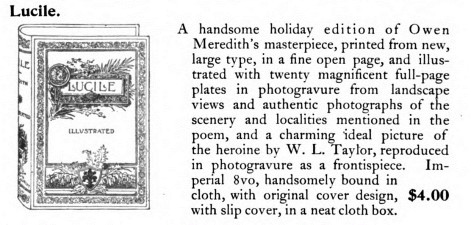
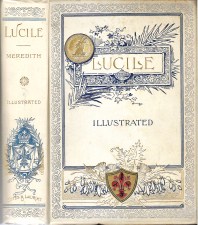
----, nd. 126x235mm, 284p. Verso titlepage: University Press: John Wilson & Son, U.S.A. Frontispiece illustrates "Pure as the pure light of dawn / she stood, bathed in morning," signed W. L. Taylor '92. Illustrations include photogravure views of European cities identified in a list of illustrations. White vellum-finish cloth stamped silver, red, gold and blue. Teg. Plain endsheets. BAP EL1: inscribed April 20, 1894, Carrollton, MO; BAP copy 2: inscribed August 6, 1894; S&EH
----. As above but with base cloth a dark gray rather than white. With original cloth dustjacket. S&EH.
THE EARL’S RETURN
This relatively short narrative poem was one of the longer pieces in Owen Meredith’s first volume of verse, Clytemnestra; The Earl's Return; The Artist, and Other Poems (London: Chapman and Hall), published in 1855. It was reprinted in all later English and American editions of Meredith’s Poems (sometimes titled Poetical Works. It was first published as a stand-alone title, illustrated with photo-etchings and wood-engravings by William Ladd Taylor (1854-1926), by Estes & Lauriat in 1886. It was claimed as the Meredith work whose popularity was exceeded in the United States only by Lucile.
Taylor's work was applauded in The American Bookmaker III:4 (October 1886), p105: "THE book-world has already had frequent occasion to admire the beauty of this artist's drawings, although he is still a very young man, having, in fact, just returned home from his studies abroad. Mr. Taylor was born in Massachusetts and began work as an illustrator about five years ago, two of which, 1884 and 1885, were spent in Europe as a pupil in the classes of the Parisian artists, Jules Lefebvre and Boulanger. Commissioned by Estes & Lauriat to illustrate their sumptuous publication, "The Earl's Return," this young artist made a pilgrimage along the Rhine, to study its towered and turreted structures, and elsewhere in Europe for correct studies of medieval interiors. So, too, with the "Dora," of Lee & Shepard, which this favored illustrator was charged with interpreting, results showing that he has made most faithful sketches of English landscapes and caught the spirit of rural life in that country."
The poem, nonetheless, is not a little bleak. As summarized by in the Publishers’ Weekly December 1886 Literary News Issue, “The Earl’s young wife is left alone for years in the lonely castle on the rock-bound coast, while her lord and master is amusing himself in the outside world. Her greatest dread is that he may return, which he finally does, and when she hears the dreadful sounds of swearing and reveling that announce his return she dies of fear. The grave is visited by a former lover, who afterwards comes to the castle as a harper and sings his love and sorrow in the fashion of that day.”
The 1886 first edition was offered in “vellum plated cloth” with Taylor’s photo-etchings printed in colors – claimed as the first use of this technique to produce a decorative trade binding -– but also in full seal morocco and “aspec” morocco. Sheets were apparently also sold to Frederick Warne for English distribution; some were dated 1885.
Estes & Lauriat continued to offer the book in various series and bindings until 1897, only in celluloid in 1896 and 1897. That cover is illustrated in the firm’s PTLA catalog and appears to be a conventionally fluted-edge celluloid wrapping with hand-painted title and decorations. In 1896, the H. M. Caldwell Company became an Estes subsidiary but did not pick up The Earl’s Return until 1901 when it was revived in a new series continued through 1912. Bindings for this edition changed from year to year but none were described as using celluloid. In 1898, Estes & Lauriat was succeeded by the Dana Estes & Company, but The Earl's Return never appeared under that imprint in PTLA catalogs.
Thus the binding shown here, with its dual embossed celluloid plates secured with four pins on each board has not been dated. It may have been a trial binding produced in only a small number of copies for some special purpose but not offered to the public. In any case it seems likely that it was devised around 1896 when Estes & Lauriat first experimented with celluloid.
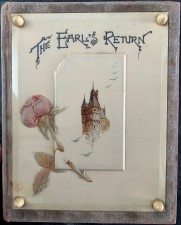
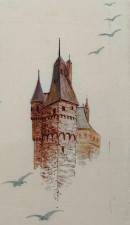
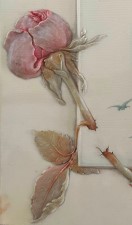
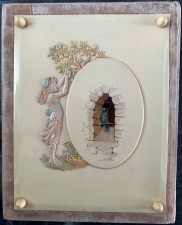

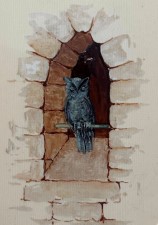
1896 & 1897. The Celluloid Series.
A dainty new style of binding for old favorites--a novel cover of celluloid, flexible, with cover designs in gold, fluted edges, each in a box. $1.50.
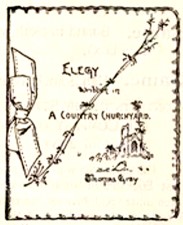
Last revised: 30 November 2024